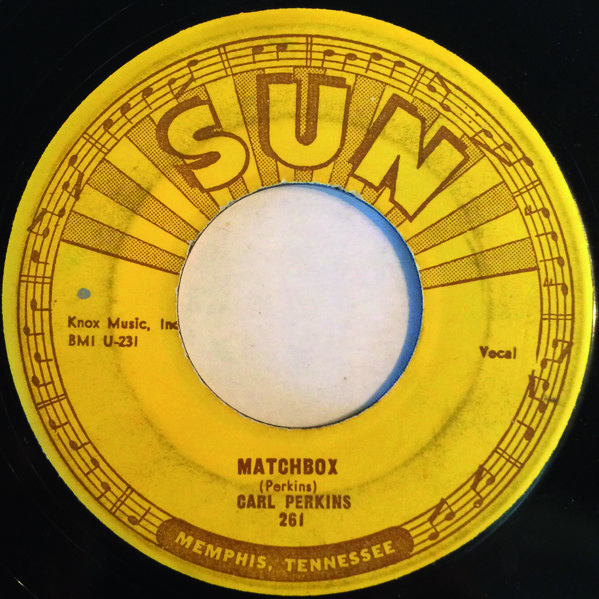A few hours before the Million Dollar Quartet gathered around the piano, Carl Perkins and Jerry Lee Lewis laid down a stone-cold rockabilly classic, one whose history stretched back over 30 years…
It’s a date that’s carved into rockabilly legend – 4 December 1956 – the day when Elvis Presley, Jerry Lee Lewis, Carl Perkins and Johnny Cash convened at Sun Studios for an impromptu jam session.
That photo of those titans of rockabilly and country (later nicknamed The Million Dollar Quartet) is among the most famous music-related shots ever taken, yet there was another historic event that happened that day at 706 Union Avenue that tends to get overlooked.
Before Elvis and Cash turned up, Perkins and Lewis had laid down a new song, one that would come to define its singer and be lauded as one of the finest rockabilly tracks of all time.
However, the origins of Matchbox aren’t simple. Though it would be wrong to call Perkins’ Matchbox a cover, we have to rewind 32 years to a song titled Lost Wandering Blues for its genesis. Performed by ‘The Mother of the Blues’, Ma Rainey, it included the lyrics, “I’m leaving this morning, with my clothes in my hand/ I won’t stop to wandering, ’til I find my man/ I’m sitting here wondering, will a matchbox hold my clothes/ I’ve got a sun to beat, I’ll be farther down the road.”
Skip to 1927 and Blind Lemon Jefferson used the matchbox reference for a 12-bar blues number of his own, titled Match Box Blues. Jefferson’s song included a few lyrical cribs from Rainey’s track, but would prove far more influential, being covered by such artists as Lead Belly, Big Bill Broonzy, The Shelton Brothers and Roy Newman & His Boys.
Fast forward once more to 4 December ’56 and Perkins and Lewis are at Sun, along with Carl’s father, Buck. Jerry Lee, who was just 21 at the time, had been booked by Sam Philips to work his piano magic on a couple of tracks they were laying down for Carl. First up was Perkins’ self-penned Your True Love, the recording of which went so well that Phillips proclaimed, “That’s a hit!”. “That song ain’t worth a damn!” came the response from the ever-cocky Lewis.
For the flipside, Buck suggested a song that he remembered from his youth, Match Box Blues. It’s not clear if Buck’s father, always more a country music man, recalled Blind Lemon Jefferson’s version or one of its many covers, but it had stayed with him. However, nobody that day had the song to hand or could remember all of its lyrics. Instead of performing an actual cover of the song, Carl cooked up a new track around the few lyrics that Buck was able to recall, while Jerry Lee began improvising a fresh boogie-woogie riff around it.
Musically, Blind Lemon Jefferson’s number was raw and spare, and lyrically told the story of a man walking away from a toxic relationship. Perkins’ version, in contrast, is rockabilly to its core and is about a “poor boy” who’s “a long way from home”. The lyrics – “Well I’m sitting here wondering/ Will a matchbox hold my clothes” – are really the only words that link Lost Wandering Blues, Match Box Blues and Matchbox.
What’s surprising now is that Matchbox was issued not as the A-side, but as the B-side to the patently inferior Your True Love. Despite the disc making No.13 on the Billboard country and western chart and No.67 on the US pop chart, it’s Matchbox which remains the most recognised and most covered.
Perkins performed the song on ABC’s country-focused Ozark Jubilee on 2 February 1957 and later on the syndicated TV show Ranch Party hosted by Tex Ritter. Sun also paid out for an advert for the single in Billboard.
Meanwhile, Matchbox was enthusiastically embraced in the UK. The Beatles were all devoted Perkins fanboys (during the group’s first tour of Scotland, in 1960, George used the pseudonym ‘Carl Harrison’, in reference to his favourite singer, while Paul McCartney described Perkins as “our big hero”) and began covering Matchbox in their live shows.
Initially it was Pete Best who would perform the song on stage, a role taken over by John Lennon after the drummer was fired. Later, when the band waxed the track for their Long Tall Sally EP, it was Best’s replacement, Ringo Starr, who stepped up to the mic. Remarkably, Perkins was visiting London at the time and was invited to observe the session at Abbey Road in June 1964.
Starr recalled feeling “very embarrassed” about his vocals due to a bad throat (he was hospitalised two days later with acute tonsillitis and pharyngitis). There were rumours at the time that Perkins contributed to the track, but there’s sadly no proof, bar a modest jam before recording took place. Ringo would get to perform Matchbox alongside Perkins and Eric Clapton 21 years later, for the televised concert, Blue Suede Shoes: A Rockabilly Session.
There was clearly something in the air around Sun Studio on 4 December 1956. But remember that The Million Dollar Quartet wouldn’t have happened had Perkins and Lewis not been booked to record two new songs that day. And had Buck Perkins not turned up alongside his son, that B-side to Your True Love would have turned out very different.
Matchbox is a unique song in that it’s almost the first example of sampling. Blind Lemon Jefferson pilfered a few lines from a song made three years before and created something completely different, and then 29 years later Carl Perkins did the same – three contrasting songs based around the same couple of lines. Given the choice of all three, however, we know which disc we’d be taking to our desert island.






